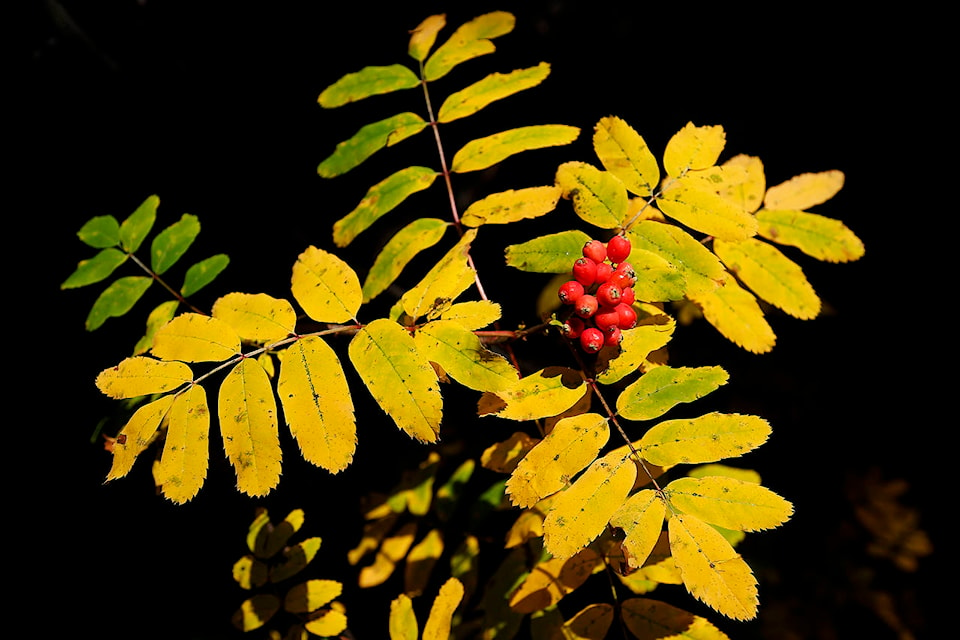Question: I’m sure I’m not the only person in Revelstoke who has noticed the lack of blossoms on mountain ash trees. Last year the ash trees were just loaded; everyone in the fall remarked on how loaded they were. This year all I have are blackberries; no blooms, hence, no berries this year. Can you help with what’s going on?
Answer: The mountain ash tree (Sorbus Aucuparia) is not truly an ash, but a member of the rose family.
If you have a tree-like plant it is likely a European native, whereas the native Canadian plant is more shrubby and bush-like.
Either way, there is sadly a reported decline in mountain ash in Canada. According to the John R. Brodie Science Centre at Brandon University in Manitoba, the widespread reports of decline are related to changes in environmental air quality.
If it were just your plant with an issue there a number of general fix approaches.
It is possible the plant received too much nitrogen and could be fertilized once in the Spring with 0-10-10 fertilizer (this related to the amount of nitrogen, phosphorus and potassium in it) to boost blooms.
Late season frosts may have damaged the flower buds or if you are seeing new shoots that wilt suddenly in late spring and turn black or brown and die it could be fire blight which is spread by insects and rain.
This infection may spread down the mountain ash tree to involve large branches.
Large cankers, or sores, can develop on the trunk and main branches if this is the case.
Trees that have been over-fertilized with nitrogen are very susceptible to this disease. If possible, destroy any nearby diseased and neglected pear, quince and apple trees, since they may harbour the fire blight organism. Between November and March, (a bit late now I know) cut off affected branches on mountain ash at least three inches below the damaged area.
Discard diseased branches in the trash. Before each cut, disinfect the pruning saw or shears with rubbing alcohol. Spray trees with an antibiotic wet powder, such as Agri-Strep, when 25 per cent of the blossoms are open and at five- to 10-day intervals during bloom.
This said, there is a possibility that pollination has decreased and the blooms have not been pollinated effectively.
This is a Canada-wide issue that is difficult to fix.
Given that this problem seems a spatially wide one, i.e at least across Revelstoke, it is likely that changes in air quality are contributors.
There is a possible link to the decreased air quality we have experienced recently in the summers due to smoke.
Increases in the atmospheric concentration of volatile phenoxy-acetic acid herbicides and ammonia gas amy also be factors.
In the presence of ammonia gas, the leaves take up three to four times the level of ambient acid herbicide in the air. These can be blown in from more industrial agricultural spots in the country.
According to the Hortline provided by the biology department at Brandon University, these are the best tips to promote growth for next season.
It says the first step to take is to prune out all dead material.
“As with any tree, you do not want dead wood to remain on the tree. This would attract harmful insects and diseases.”
An important thing to remember when pruning is to sterilize your pruning tools.
By dipping the pruning tools in a solution of one part bleach to nine parts water you will reduce the chance of spreading disease that you are unaware of to all your pruning points, says the hotline.
It adds it is also important to keep your pruning tools sharp, as uneven cuts will increase the chance of disease.
To determine where the dead wood ends and live wood begins, make nicks in the branch, moving towards the trunk from the dead wood, sterilizing the knife between each cut.
Once you find that there is green under the bark, you know that the wood is alive. Prune four to six inches into live wood or flush with the next major branch or main trunk.
Once all of the pruning is done, spray the tree with Later’s Copper. This will protect the tree from fungal diseases. Since your tree is weakened, we suggest that you adopt a regular care routine of spraying the tree with a copper spray once every fall and once every spring. Also, fertilize once every spring.”
I hope this helps, fingers crossed the mountain ash rebounds and we get to see their beautiful blooms for years to come. Thanks for your question.
If anyone has a science or nature related question they would like Stoked on Science to investigate please email the editor or stokedonscience@gmail.com.
Jade Harvey has a degree in physical geography. and likes to share her passion for science through writing and telling stories.
